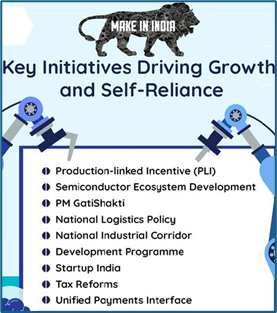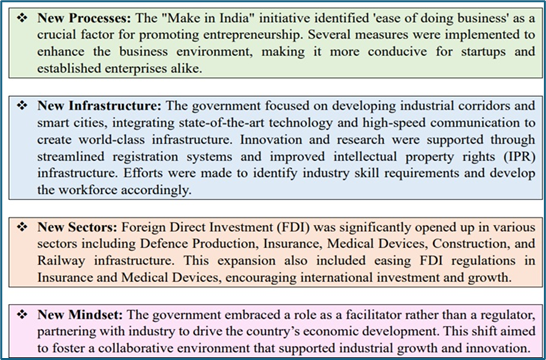Why in news?
Launched on September 25, 2014, by PM Modi, the "Make in India" initiative marked a pivotal shift in India's economic strategy.
The 10th anniversary of the initiative in 2024 celebrates its success in reinvigorating the Indian economy, boosting global competitiveness, and setting India on a path to self-reliance (Atmanirbhar Bharat).
What’s in today’s article?
Make in India (MII)
- Background
- Make in India came in response to a critical economic situation where, by 2013, India's growth rate had plummeted to its lowest in a decade.
- The promise of the BRICS Nations (Brazil, Russia, India, China and South Africa) had faded, and India was tagged as one of the so-called ‘Fragile Five’.
- The country stood at a crossroads, with questions arising about whether it was too large to succeed or too large to fail, necessitating an urgent and substantial economic push.
- About
- In September 2014, PM Modi launched the "Make in India" initiative as part of a broader strategy to revitalize the nation's economy.
- The initiative aimed to transform India into a global design and manufacturing hub.
- At its core, "Make in India" sought to create a robust manufacturing ecosystem that could elevate India's economic position and provide employment to its vast workforce.
- The initiative emphasized the importance of making India a global hub for design, innovation, and manufacturing across a wide range of sectors.
- Key Sectors Under MII
- The initiative focused on 27 sectors, grouped under two broad categories:
- Manufacturing Sectors: Aerospace and Defence; Automotive and Auto Components; Pharmaceuticals and Medical Devices; Biotechnology; Textiles and Apparels; Chemicals and Petrochemicals; Electronics System Design and Manufacturing (ESDM); Food Processing; Gems and Jewellery; Railways, and more.
- Service Sectors: Information Technology (IT) and IT-enabled Services (ITeS); Tourism and Hospitality; Medical Value Travel; Transport and Logistics Services; Accounting and Finance Services; Audio Visual and Legal Services, among others.
- Pillars of MII
- Major initiatives under MII

- Production Linked Incentive (PLI) Schemes
- The PLI schemes have provided a financial outlay of ₹1.97 lakh crore ($26 billion) across 14 key sectors, including electronics, automobiles, pharmaceuticals, and textiles.
- As of 2024, these schemes have approved 755 applications, leading to ₹1.23 lakh crore in investment and generating employment for around 8 lakh individuals.
- PM GatiShakti
- Introduced in 2021, PM GatiShakti is a national infrastructure plan aimed at achieving multimodal connectivity through the integration of transportation, energy, and communication networks.
- The program brings together 36 ministries and departments to enhance logistics efficiency and synchronize project implementation.
- The "seven engines" of the program—railways, roads, ports, waterways, airports, mass transport, and logistics infrastructure—drive economic growth and job creation.
- Semiconductor Ecosystem Development
- To reduce dependence on foreign imports and establish self-reliance in critical technologies, the government launched the Semicon India Programme with an outlay of ₹76,000 crore.
- National Logistics Policy (NLP)
- Unveiled in 2022, the NLP complements the PM GatiShakti by focusing on reducing logistics costs, improving India’s Logistics Performance Index (LPI) ranking, and building a sustainable logistics network.
- It aims to streamline logistics through digital systems, standardization, and human resource development.
- Industrialization and Urbanization
- The National Industrial Corridor Development Programme is India's largest infrastructure initiative aimed at creating "Smart Cities" and advanced industrial hubs.
- The program promotes manufacturing growth and systematic urbanization through integrated industrial corridors with multi-modal connectivity.
- The recent approval of 12 new projects, with an investment of ₹28,602 crore, strengthens India’s position as a global manufacturing and investment destination.
- Startup India
- Launched on January 2016, the Startup India initiative supports entrepreneurs and aims to build a robust startup ecosystem.
- By September 2024, India has the third-largest startup ecosystem, with 148,931 DPIIT-recognized startups generating over 15.5 lakh jobs.
- Tax Reforms
- The introduction of the GST on July 1, 2017, streamlined India's tax system by unifying 36 states and union territories into a common market.
- Unified Payments Interface (UPI)
- India’s UPI has become a global leader in digital payments, processing 46% of the world’s real-time transactions.
- Between April and July 2024, UPI processed nearly ₹81 lakh crore, highlighting its robust infrastructure and growing consumer trust.
- Ease of Doing Business
- India made remarkable progress in improving its business environment, climbing from 142nd in 2014 to 63rd in the World Bank’s Doing Business Report (DBR) 2020, published in October 2019.
- This jump reflects the government’s sustained efforts to simplify regulations, reduce bureaucratic hurdles, and create a more business-friendly environment, significantly boosting investor confidence.
- Record FDI to Boost MII
- MII has been significantly boosted by record FDI inflows, driven by simplified FDI rules and improved ease of doing business.
- FDI inflows increased from $45.14 billion in 2014-15 to a record $84.83 billion in 2021-22.
- Between 2014 and 2024, India attracted $667.41 billion in FDI, with total inflows reaching $70.95 billion in FY 2023-24.
- Key Achievements
- Manufacturing Growth
- India has emerged as the world's second-largest mobile phone manufacturer.
- Mobile exports surged from Rs 1,556 crore in 2014 to Rs 1.2 lakh crore by 2024.
- The electronics sector grew to USD 155 billion in FY23, with mobile phones accounting for 43% of production.
- Self-Reliance in Defence
- India has made strides in defence production, highlighted by the launch of INS Vikrant, the country’s first indigenous aircraft carrier.
- Defence production has reached ₹1.27 lakh crore, with exports to over 90 countries.
- 'Made in Bihar' boots are now part of the Russian Army’s equipment
- Global Export Growth
- India recorded merchandise exports worth $437.06 billion in FY 2023-24, marking its growing role in global trade.
- Employment Creation
- The initiative has generated millions of jobs across various sectors, including 8 lakh jobs through PLI schemes alone.
- Other achievements
- Kashmir willow bats have become a global favorite.
- Amul has expanded its presence by launching its dairy products in the US.
- The textile industry has created a staggering 14.5 crore jobs across the country.
- India produces an impressive 400 million toys annually, with 10 new toys being created every second.
- Criticism
- Experts highlights that the scheme has largely been ineffective in either increasing the share of manufacturing in GDP or attracting major investments in the country.
- Even on the employment front, manufacturing jobs remain few and far between.
- The share of value addition by manufacturing sector is 15.9 percent in 2023-24 compared to 16.7 percent of GDP (in constant price) in 2013-14.
- Even in terms of FDI, net FDI inflows have come down from 1.5 percent of GDP in 2013-14 to 0.8 percent in 2023-24.
- Challenges
- Ease of doing business is still a far cry from what is claimed on paper.
- High incidence of taxation and high handedness in dealing with tax litigation cases.
- Scarcity of skilled workers in India and competition from Vietnam and Bangladesh for low-skilled manufacturing.
- Conclusion
- As "Make in India" enters its second decade, it stands as a testament to India's determination to reshape its manufacturing landscape and enhance its global standing.
- With the support of strategic reforms, such as the PLI schemes, PM GatiShakti, and the National Logistics Policy, India has emerged as a competitive and self-reliant economy.
- The success of indigenous projects like the Vande Bharat trains, the INS Vikrant, and the growing electronics sector signals a promising future for India’s industrial and manufacturing sectors.











